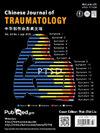脱位会恶化上翻-外旋踝关节骨折的术后功能效果
IF 1.9
4区 医学
Q2 ORTHOPEDICS
引用次数: 0
摘要
目的探讨旋外旋转(SER)踝关节骨折脱位与功能预后的关系。方法对2015年1月至2021年12月在某大型外伤中心手术治疗的踝关节骨折患者进行回顾性病例系列研究。入选标准为18 - 65岁的中青年SER踝关节骨折患者,符合Lauge-Hansen分类标准,在创伤中心行手术治疗。排除标准为严重危及生命的疾病、开放性骨折、骨折延迟3周以上、骨折部位≥2个等。然后将患者分为脱位组和无脱位组。收集并分析患者人口统计、损伤特征、手术相关结果和术后功能结果。术后1年面对面随访,由2名经验丰富的骨科医生采用足踝结局评分(FAOS)和美国骨科足踝协会踝关节后足评分评估SER踝关节骨折的功能结局。相关数据采用SPSS 22.0版,采用卡方检验或t检验。结果研究期间共发生371例踝关节骨折。其中SER型190例(51.2%),合并位错69例(36.3%)。与无脱位组比较,脱位组在性别、年龄构成、骨折类型、糖尿病、吸烟史、术前等待时间、手术时间、住院时间等方面均无统计学差异(p >;0.05),但Lauge-Hansen损伤等级显著升高(p <;0.001)和关节联合螺钉固定率(p = 0.033)。此外,功能恢复较差,表明运动/娱乐量表的FAOS明显较低(p <;0.001)。亚组分析显示,在SER IV型踝关节骨折患者中,FAOS在疼痛(p = 0.042)和运动/运动量表(p <;0.001)。美国骨科足踝学会踝关节后足评分显示脱位与无脱位患者无显著差异。结论SER型踝关节骨折脱位损伤更严重,对功能恢复有负面影响,主要表现为疼痛加重,运动功能下降,尤以SER型踝关节骨折为甚。本文章由计算机程序翻译,如有差异,请以英文原文为准。
Dislocations deteriorate postoperative functional outcomes in supination-external rotation ankle fractures
Purpose
To assess the relationship between dislocation and functional outcomes in supination-external rotation (SER) ankle fractures.
Methods
A retrospective case series study was performed on patients with ankle fractures treated surgically at a large trauma center from January 2015 to December 2021. The inclusion criteria were young and middle-aged patients of 18 – 65 years with SER ankle fractures that can be classified by Lauge-Hansen classification and underwent surgery at our trauma center. Exclusion criteria were serious life-threatening diseases, open fractures, fractures delayed for more than 3 weeks, fracture sites ≥ 2, etc. Then patients were divided into dislocation and no-dislocation groups. Patient demographics, injury characteristics, surgery-related outcomes, and postoperative functional outcomes were collected and analyzed. The functional outcomes of SER ankle fractures were assessed postoperatively at 1-year face-to-face follow-up using the foot and ankle outcome score (FAOS) and American Orthopedic Foot and Ankle Society ankle hindfoot score and by 2 experienced orthopedic physicians. Relevant data were analyzed using SPSS version 22.0 by Chi-square or t-test.
Results
During the study period, there were 371 ankle fractures. Among them, 190 (51.2%) were SER patterns with 69 (36.3%) combined with dislocations. Compared with the no-dislocation group, the dislocation group showed no statistically significant differences in gender, age composition, fracture type, diabetes, or smoking history, preoperative waiting time, operation time, and length of hospital stay (all p > 0.05), but a significantly higher Lauge-Hansen injury grade (p < 0.001) and syndesmotic screw fixation rate (p = 0.033). Moreover, the functional recovery was poorer, revealing a significantly lower FAOS in the sport/rec scale (p < 0.001). Subgroup analysis showed that among SER IV ankle fracture patients, FAOS was much lower in pain (p = 0.042) and sport/rec scales (p < 0.001) for those with dislocations. American Orthopedic Foot and Ankle Society ankle hindfoot score revealed no significant difference between dislocation and no-dislocation patients.
Conclusion
Dislocation in SER ankle fractures suggests more severe injury and negatively affects functional recovery, mainly manifested as more pain and poorer motor function, especially in SER IV ankle cases.
求助全文
通过发布文献求助,成功后即可免费获取论文全文。
去求助
来源期刊

Chinese Journal of Traumatology
ORTHOPEDICS-
CiteScore
3.80
自引率
4.80%
发文量
1707
审稿时长
28 weeks
期刊介绍:
Chinese Journal of Traumatology (CJT, ISSN 1008-1275) was launched in 1998 and is a peer-reviewed English journal authorized by Chinese Association of Trauma, Chinese Medical Association. It is multidisciplinary and designed to provide the most current and relevant information for both the clinical and basic research in the field of traumatic medicine. CJT primarily publishes expert forums, original papers, case reports and so on. Topics cover trauma system and management, surgical procedures, acute care, rehabilitation, post-traumatic complications, translational medicine, traffic medicine and other related areas. The journal especially emphasizes clinical application, technique, surgical video, guideline, recommendations for more effective surgical approaches.
 求助内容:
求助内容: 应助结果提醒方式:
应助结果提醒方式:


